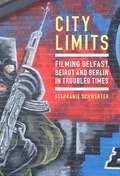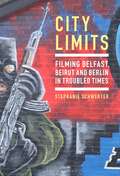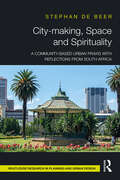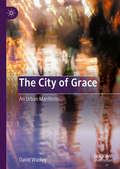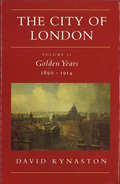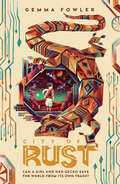- Table View
- List View
City Lights (BFI Film Classics)
by Charles J. MalandIn 1967, Charlie Chaplin told, 'I think I like 'City Lights' the best of all my films.' Based on archival research of Chaplin's production records, this work offers a history of the film's production and reception, as well as an examination of the film itself, with special attention to the sources of the final scene's emotional power.
City Lights (BFI Film Classics)
by Charles J. MalandIn 1967, Charlie Chaplin told, 'I think I like 'City Lights' the best of all my films.' Based on archival research of Chaplin's production records, this work offers a history of the film's production and reception, as well as an examination of the film itself, with special attention to the sources of the final scene's emotional power.
City Limits: Filming Belfast, Beirut and Berlin in Troubled Times
by Stephanie SchwerterBelfast, Beirut and Berlin are notorious for their internal boundaries and borders. As symbols for political disunion, the three cities have inspired scriptwriters and directors from diverse cultural backgrounds. Despite their different histories, they share a wide range of features central to divided cities. In each city, particular territories take on specific symbolic and psychological meanings. Following a comparative approach, this book concentrates on the cinematographic representations of Belfast, Beirut and Berlin. Filmmakers are in constant search for new ways in order to engage with urban division. Making use of a variety of genres reaching from thriller to comedy, they explore the three cities' internal and external borders, as well as the psychological boundaries existing between citizens belonging to different communities. Among the characters featuring in films set in Belfast, Berlin and Beirut we may count dangerous gunmen, prisoners' wives, soldiers and snipers, but also comic Stasi-members, punk aficionados and fake nuns. The various characters contribute to the creation of a multifaceted image of city limits in troubled times.
City Limits: Filming Belfast, Beirut and Berlin in Troubled Times
by Stephanie SchwerterBelfast, Beirut and Berlin are notorious for their internal boundaries and borders. As symbols for political disunion, the three cities have inspired scriptwriters and directors from diverse cultural backgrounds. Despite their different histories, they share a wide range of features central to divided cities. In each city, particular territories take on specific symbolic and psychological meanings. Following a comparative approach, this book concentrates on the cinematographic representations of Belfast, Beirut and Berlin. Filmmakers are in constant search for new ways in order to engage with urban division. Making use of a variety of genres reaching from thriller to comedy, they explore the three cities' internal and external borders, as well as the psychological boundaries existing between citizens belonging to different communities. Among the characters featuring in films set in Belfast, Berlin and Beirut we may count dangerous gunmen, prisoners' wives, soldiers and snipers, but also comic Stasi-members, punk aficionados and fake nuns. The various characters contribute to the creation of a multifaceted image of city limits in troubled times.
City Logistics 1: New Opportunities and Challenges
by Eiichi Taniguchi Russell G. ThompsonThis volume of three books presents recent advances in modelling, planning and evaluating city logistics for sustainable and liveable cities based on the application of ICT (Information and Communication Technology) and ITS (Intelligent Transport Systems). It highlights modelling the behaviour of stakeholders who are involved in city logistics as well as planning and managing policy measures of city logistics including cooperative freight transport systems in public-private partnerships. Case studies of implementing and evaluating city logistics measures in terms of economic, social and environmental benefits from major cities around the world are also given.
City Logistics 1: New Opportunities and Challenges
by Eiichi Taniguchi Russell G. ThompsonThis volume of three books presents recent advances in modelling, planning and evaluating city logistics for sustainable and liveable cities based on the application of ICT (Information and Communication Technology) and ITS (Intelligent Transport Systems). It highlights modelling the behaviour of stakeholders who are involved in city logistics as well as planning and managing policy measures of city logistics including cooperative freight transport systems in public-private partnerships. Case studies of implementing and evaluating city logistics measures in terms of economic, social and environmental benefits from major cities around the world are also given.
City Logistics 2: Modeling and Planning Initiatives
by Eiichi Taniguchi Russell G. ThompsonThis volume of three books presents recent advances in modelling, planning and evaluating city logistics for sustainable and liveable cities based on the application of ICT (Information and Communication Technology) and ITS (Intelligent Transport Systems). It highlights modelling the behaviour of stakeholders who are involved in city logistics as well as planning and managing policy measures of city logistics including cooperative freight transport systems in public-private partnerships. Case studies of implementing and evaluating city logistics measures in terms of economic, social and environmental benefits from major cities around the world are also given.
City Logistics 2: Modeling and Planning Initiatives
by Eiichi Taniguchi Russell G. ThompsonThis volume of three books presents recent advances in modelling, planning and evaluating city logistics for sustainable and liveable cities based on the application of ICT (Information and Communication Technology) and ITS (Intelligent Transport Systems). It highlights modelling the behaviour of stakeholders who are involved in city logistics as well as planning and managing policy measures of city logistics including cooperative freight transport systems in public-private partnerships. Case studies of implementing and evaluating city logistics measures in terms of economic, social and environmental benefits from major cities around the world are also given.
City Logistics 3: Towards Sustainable and Liveable Cities
by Eiichi Taniguchi Russell G. ThompsonThis volume of three books presents recent advances in modelling, planning and evaluating city logistics for sustainable and liveable cities based on the application of ICT (Information and Communication Technology) and ITS (Intelligent Transport Systems). It highlights modelling the behaviour of stakeholders who are involved in city logistics as well as planning and managing policy measures of city logistics including cooperative freight transport systems in public-private partnerships. Case studies of implementing and evaluating city logistics measures in terms of economic, social and environmental benefits from major cities around the world are also given.
City Logistics 3: Towards Sustainable and Liveable Cities
by Eiichi Taniguchi Russell G. ThompsonThis volume of three books presents recent advances in modelling, planning and evaluating city logistics for sustainable and liveable cities based on the application of ICT (Information and Communication Technology) and ITS (Intelligent Transport Systems). It highlights modelling the behaviour of stakeholders who are involved in city logistics as well as planning and managing policy measures of city logistics including cooperative freight transport systems in public-private partnerships. Case studies of implementing and evaluating city logistics measures in terms of economic, social and environmental benefits from major cities around the world are also given.
City-making, Space and Spirituality: A Community-Based Urban Praxis with Reflections from South Africa
by Stéphan de BeerThis book is about the soul of the city, embodied in its spaces and people. It traces dynamics in inner city neighbourhoods of South Africa’s post-apartheid capital, Pretoria. Viewing the city through its most vulnerable people and places, it recognizes that urban space is never neutral and shaped by competing value frameworks. The first part of the book invites planners, city-makers, and ordinary urban citizens, to consider a new self-understanding, reclaiming their agency in the city-making process. Through the metaphor of "becoming like children", planning practice is deconstructed and re-imagined. A praxis-based methodology is presented, cultivating four distinct moments of entering, reading, imagining and co-constructing the city. After deconstructing urban spaces and discourses, the second part of the book explores a concrete spirituality and ethic of urban space. It argues for a shift from planning as technocracy, to planning as immersed, participatory artistry: opening up to the "genius" of space, responsive to urban cries, and joining to construct new, soul-full spaces. Local communities and interconnected movements become embodiments of urban alternatives – through resistance and reconstruction; building on local assets; animating local reclamations; and weaving nets of hope that will span the entire city. Providing a concrete methodology for city-making that is rooted in a community-based urban praxis, this book will be of interest to urban planning researchers, professional planners and designers and also grass-root community developers or activists.
City-making, Space and Spirituality: A Community-Based Urban Praxis with Reflections from South Africa
by Stéphan de BeerThis book is about the soul of the city, embodied in its spaces and people. It traces dynamics in inner city neighbourhoods of South Africa’s post-apartheid capital, Pretoria. Viewing the city through its most vulnerable people and places, it recognizes that urban space is never neutral and shaped by competing value frameworks. The first part of the book invites planners, city-makers, and ordinary urban citizens, to consider a new self-understanding, reclaiming their agency in the city-making process. Through the metaphor of "becoming like children", planning practice is deconstructed and re-imagined. A praxis-based methodology is presented, cultivating four distinct moments of entering, reading, imagining and co-constructing the city. After deconstructing urban spaces and discourses, the second part of the book explores a concrete spirituality and ethic of urban space. It argues for a shift from planning as technocracy, to planning as immersed, participatory artistry: opening up to the "genius" of space, responsive to urban cries, and joining to construct new, soul-full spaces. Local communities and interconnected movements become embodiments of urban alternatives – through resistance and reconstruction; building on local assets; animating local reclamations; and weaving nets of hope that will span the entire city. Providing a concrete methodology for city-making that is rooted in a community-based urban praxis, this book will be of interest to urban planning researchers, professional planners and designers and also grass-root community developers or activists.
City Networks: Collaboration and Planning for Health and Sustainability (Springer Optimization and Its Applications #128)
by Athanasia Karakitsiou Athanasios Migdalas Stamatina Th. Rassia Panos M. PardalosSustainable development within urban and rural areas, transportation systems, logistics, supply chain management, urban health, social services, and architectural design are taken into consideration in the cohesive network models provided in this book. The ideas, methods, and models presented consider city landscapes and quality of life conditions based on mathematical network models and optimization. Interdisciplinary Works from prominent researchers in mathematical modeling, optimization, architecture, engineering, and physics are featured in this volume to promote health and well-being through design. Specific topics include:- Current technology that form the basis of future living in smart cities- Interdisciplinary design and networking of large-scale urban systems - Network communication and route traffic optimization- Carbon dioxide emission reduction - Closed-loop logistics chain management and operation- Modeling the effect urban environments on aging- Health care infrastructure- Urban water system management- Architectural design optimization Graduate students and researchers actively involved in architecture, engineering, building physics, logistics, supply chain management, and mathematical optimization will find the interdisciplinary work presented both informative and inspiring for further research.
City of American Dreams: A History of Home Ownership and Housing Reform in Chicago, 1871-1919 (Historical Studies of Urban America)
by Margaret GarbIn this vivid portrait of life in Chicago in the fifty years after the Civil War, Margaret Garb traces the history of the American celebration of home ownership. As the nation moved from an agrarian to an industrialized urban society, the competing visions of capitalists, reformers, and immigrants turned the urban landscape into a testing ground for American values. Neither a natural progression nor an inevitable outcome, the ideal of home ownership emerged from the struggles of industrializing cities. Garb skillfully narrates these struggles, showing how the American infatuation with home ownership left the nation's cities sharply divided along class and racial lines. Based on research of real estate markets, housing and health reform, and ordinary homeowners—African American and white, affluent and working class—City of American Dreams provides a richly detailed picture of life in one of America's great urban centers. Garb shows that the pursuit of a single-family house set on a tidy yard, commonly seen as the very essence of the American dream, resulted from clashes of interests and decades of struggle.
The City of Domes
by John D. BarryA walk with an architect about the courts and palaces of the Panama Pacific International Exposition
City of Forests, City of Farms: Sustainability Planning for New York City’s Nature
by Lindsay K. CampbellCity of Forests, City of Farms is a history of recent urban forestry and agriculture policy and programs in New York City. Centered on the 2007 initiative PlaNYC, this account tracks the development of policies that increased sustainability efforts in the city and dedicated more than $400 million dollars to trees via the MillionTreesNYC campaign. Lindsay K. Campbell uses PlaNYC to consider how and why nature is constructed in New York City. Campbell regards sustainability planning as a process that unfolds through the strategic interplay of actors, the deployment of different narrative frames, and the mobilizing and manipulation of the physical environment, which affects nonhuman animals and plants as well as the city's residents.Campbell zeroes in on a core omission in PlaNYC's original conception and funding: Despite NYC having a long tradition of community gardening, particularly since the fiscal crisis of the 1970s, the plan contained no mention of community gardens or urban farms. Campbell charts the change of course that resulted from burgeoning public interest in urban agriculture and local food systems. She shows how civic groups and elected officials crafted a series of visions and plans for local food systems that informed the 2011 update to PlaNYC. City of Forests, City of Farms is a valuable tool that allows us to understand and disentangle the political decisions, popular narratives, and physical practices that shape city greening in New York City and elsewhere.
The City of Grace: An Urban Manifesto
by David WadleyIn this sweeping appraisal of the urban condition, David Wadley argues that anything less that high-level resolution in modelling the well-being of inhabitants is wasting precious time. Humanity is encountering rising entropy, caused by unsustainable economic and demographic expansion. Supported by a strong interdisciplinary backdrop featuring systems and crisis theories, The City of Grace tackles these obstacles by picturing gracious function and graceful form in a human-scale settlement. In an attempt to salvage things lost in the teleology of urban development over the last 100 years, the outlook is both heterodox and contrarian. How long can we all go on in the present way? In addressing grace, a more elevated concept than those focusing previous urban analyses, this manifesto aims not to placate or please but, instead, to get humanity to face the encompassing realities it tries so hard to forget.
City of Light: The Making Of Modern Paris (The Landmark Library #10)
by Rupert ChristiansenA sparkling account of the nineteenth-century rebuilding of Paris as the most beautiful city in the world, as part of the stunning Landmark Library series. 'This really is an impressive book' Sebastian Faulks. 'Brisk, vivid and unexpectedly stirring... No one writes as evocatively and entertainingly about Paris as Christiansen does' Mail on Sunday. 'Every page is a pleasure, every building, every gas lamp brought shimmering to life... Don't board the Eurostar without a copy' The Times. 'A wonderful book, amazingly vivid... But also a truly original work of scholarship' Theodore Zeldin. In 1853 the French emperor Louis Napoleon inaugurated a vast and ambitious programme of public works, directed by Georges-Eugène Haussmann, the prefect of the Seine. Haussmann's renovation of Paris would transform the old medieval city of squalid slums and disease-ridden alleyways into a 'City of Light' – characterised by wide boulevards, apartment blocks, parks, squares and public monuments, new railway stations and department stores and a new system of public sanitation. City of Light charts a fifteen-year project of urban renewal which – despite the interruptions of war, revolution, corruption and bankruptcy – would set a template for nineteenth and early twentieth-century urban planning and create the enduring and globally familiar layout of modern Paris.
The City Of London Volume 2: Golden Years 1890-1914
by David KynastonBetween 1890 and 1914 the City of London was all dominant as Britain's legendary gold standard reigned supreme across the globe. Golden Years anatomises an elite at the height of its powers. Combining brilliant scholarship with high entertainment, and drawing on an unparalleled range of original sources, David Kynaston brings the city triumphant into the mainstream of British and world history.
City of Play: An Architectural and Urban History of Recreation and Leisure
by Rodrigo Pérez ArceCity of Play shows how play is built into the very fabric of the modern city. From playgrounds to theme parks, skittle alleys to swimming pools, to the countless uncontrolled spaces which the urban habitat affords – play is by no means just a childhood affair. A myriad essentially unproductive playful pursuits have, through time, modelled the modern city and landscape. Architect and scholar Rodrigo Pérez de Arce's erudite, original, and often surprising study explores a curiously neglected dimension of architectural design and practice: ludic space. It is an architectural history of the playground – from the hippodrome to the Situationist city – of space released from productive ends in the pursuit of leisure. But this is more than just a book about how architecture has incorporated play into its spaces and structures, it is a history of the modern city itself. The ludic imagination impregnated modernist ideals, and what begins with the playground ends with a re-consideration of the whole sweep of the modern movement through the filter of leisure and play.Because play is such a basic or fundamental human experience, the book re-grounds the architect's concerns with those of non-architects – and not only those of adults but also of children. It seeks to give everyone – architects and other ordinary city-dwellers alike – a better understanding about what is at stake in the making of the public spaces of our cities.
City of Play: An Architectural and Urban History of Recreation and Leisure
by Rodrigo Pérez ArceCity of Play shows how play is built into the very fabric of the modern city. From playgrounds to theme parks, skittle alleys to swimming pools, to the countless uncontrolled spaces which the urban habitat affords – play is by no means just a childhood affair. A myriad essentially unproductive playful pursuits have, through time, modelled the modern city and landscape. Architect and scholar Rodrigo Pérez de Arce's erudite, original, and often surprising study explores a curiously neglected dimension of architectural design and practice: ludic space. It is an architectural history of the playground – from the hippodrome to the Situationist city – of space released from productive ends in the pursuit of leisure. But this is more than just a book about how architecture has incorporated play into its spaces and structures, it is a history of the modern city itself. The ludic imagination impregnated modernist ideals, and what begins with the playground ends with a re-consideration of the whole sweep of the modern movement through the filter of leisure and play.Because play is such a basic or fundamental human experience, the book re-grounds the architect's concerns with those of non-architects – and not only those of adults but also of children. It seeks to give everyone – architects and other ordinary city-dwellers alike – a better understanding about what is at stake in the making of the public spaces of our cities.
City of Refuge: Separatists and Utopian Town Planning
by Michael J. LewisThe vision of Utopia obsessed the nineteenth-century mind, shaping art, literature, and especially town planning. In City of Refuge, Michael Lewis takes readers across centuries and continents to show how Utopian town planning produced a distinctive type of settlement characterized by its square plan, collective ownership of properties, and communal dormitories. Some of these settlements were sanctuaries from religious persecution, like those of the German Rappites, French Huguenots, and American Shakers, while others were sanctuaries from the Industrial Revolution, like those imagined by Charles Fourier, Robert Owen, and other Utopian visionaries.Because of their differences in ideology and theology, these settlements have traditionally been viewed separately, but Lewis shows how they are part of a continuous intellectual tradition that stretches from the early Protestant Reformation into modern times. Through close readings of architectural plans and archival documents, many previously unpublished, he shows the network of connections between these seemingly disparate Utopian settlements—including even such well-known town plans as those of New Haven and Philadelphia.The most remarkable aspect of the city of refuge is the inventive way it fused its eclectic sources, ranging from the encampments of the ancient Israelites as described in the Bible to the detailed social program of Thomas More's Utopia to modern thought about education, science, and technology. Delving into the historical evolution and antecedents of Utopian towns and cities, City of Refuge alters notions of what a Utopian community can and should be.
City of Refuge: Separatists and Utopian Town Planning
by Michael J. LewisThe vision of Utopia obsessed the nineteenth-century mind, shaping art, literature, and especially town planning. In City of Refuge, Michael Lewis takes readers across centuries and continents to show how Utopian town planning produced a distinctive type of settlement characterized by its square plan, collective ownership of properties, and communal dormitories. Some of these settlements were sanctuaries from religious persecution, like those of the German Rappites, French Huguenots, and American Shakers, while others were sanctuaries from the Industrial Revolution, like those imagined by Charles Fourier, Robert Owen, and other Utopian visionaries.Because of their differences in ideology and theology, these settlements have traditionally been viewed separately, but Lewis shows how they are part of a continuous intellectual tradition that stretches from the early Protestant Reformation into modern times. Through close readings of architectural plans and archival documents, many previously unpublished, he shows the network of connections between these seemingly disparate Utopian settlements—including even such well-known town plans as those of New Haven and Philadelphia.The most remarkable aspect of the city of refuge is the inventive way it fused its eclectic sources, ranging from the encampments of the ancient Israelites as described in the Bible to the detailed social program of Thomas More's Utopia to modern thought about education, science, and technology. Delving into the historical evolution and antecedents of Utopian towns and cities, City of Refuge alters notions of what a Utopian community can and should be.
City Of Rust (ebook)
by Gemma FowlerRailey dreams of winning the drone races with her bio-robotic gecko friend, Atti. But when a bounty hunter crashes their biggest race yet, the pair are forced to flee to the feared Junker clans who mine the rubbish orbiting the Earth. Rescued by a couple of Junker kids, they discover a danger bigger than anything they’d imagined – but can three kids, a gecko and an ancient computer save the world against the huge trash bomb (and its power-crazed creator) threatening to destroy the world? In this fun, original and thrilling middle-grade debut from Gemma Fowler, think Star Wars meets Wall-E in an ecologically-themed mystery adventure – sci-fi for a new generation!
A City of Sadness (BFI Film Classics)
by Berenice ReynaudWinner of the Golden Lion in Venice in 1989, A City of Sadness introduced Western audiences to the richness of New Taiwanese Cinema. Its director, Hou Hsiao-hsien is now recognised as one of the most profoundly original auteurs in contemporary cinema. A City of Sadness revisits a painful episode in recent Taiwanese history, creating an elliptical and impressionistic picture of Chiang Kai-shek's takeover of the island after the defeat of his Kuomintang army by Mao Zedong. Taiwan's politics and the suffering of her inhabitants are invoked by Hou in the story of an extended family of four brothers. The first Taiwanese film shot in direct sound, A City of Sadness echoes the forgotten voices of ordinary people facing political repression. Berenice Reynaud deciphers the complex social and historical threads that combine in the film while analysing its aesthetics in the context of Hou's entire career. His journey from being a commercial director to becoming the famed master of long takes and painterly compositions is referred to the history of Taiwanese cinema and the philosophy of forms in Chinese art.


